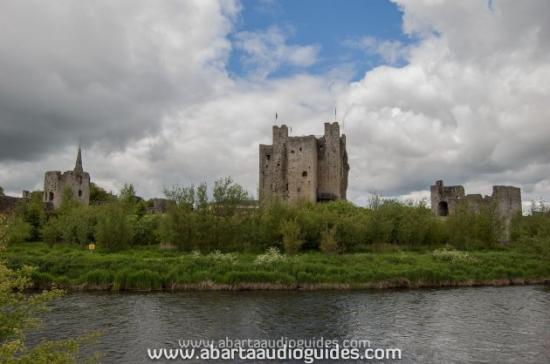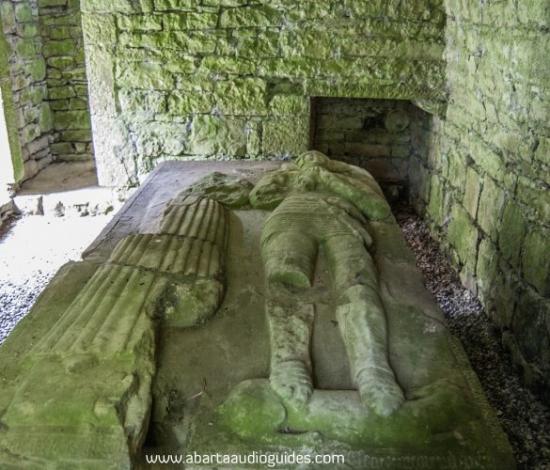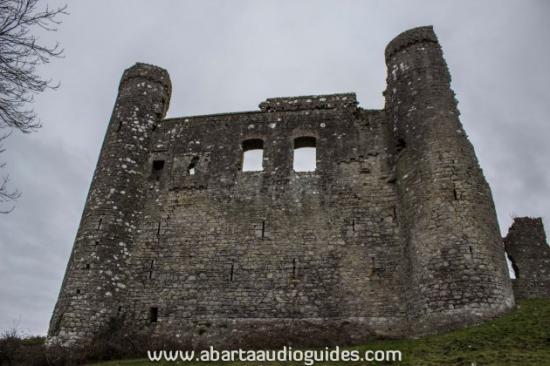PART.2
Medieval Ireland (1200–1600 AD)
In the late 1160s the unpopular King of Leinster, Diarmait Mac Murrough decided he needed the aid of a powerful ally to help him to regain the lands he had lost to his rivals. He was alone facing a vast confederation of enemies. He sought help from the Norman King of England, Henry II.
Henry gave permission for some of his knights to travel to Ireland. Richard de Clare, known as Strongbow, was the political leader of the invasion and the powerful, professional and experienced Norman forces quickly seized Waterford, Wexford and Dublin.
The town of Trim in County Meath is the site of the largest Norman Castle in Ireland.

Trim Castle
It was built by the powerful Hugh de Lacy in the late twelfth century. It really is a fantastic example of the power of the Norman magnates, and today you can enjoy a great guided tour of the keep of the castle.
Trim is also home to a large collection of fantastic medieval buildings, I strongly recommend taking the River Walk that runs along the banks of the Boyne from the carpark below Trim Castle. You’ll encounter several wonderful medieval buildings within a short 20 minute stroll. See here for more information.
As well as fortifications like Trim, the Norman lords also became the new benefactors of existing monasteries like Mellifont and Bective Abbey and they founded many new monasteries with continental monastic orders like the Augustinians, Benedictines and the Fratres Cruciferi, and the Boyne Valley has a number of examples to enjoy.
One of my favourite heritage sites anywhere in Ireland is the wonderfully atmospheric old church of St Lawrence at Rathmore, just outside of Athboy. This site is a 15th century manorial church that served the now destroyed castle of the Plunkett family.

The tomb of Sir Thomas Plunkett and his wife Marion Cruise at Rathmore
Inside the church you can find lots of great medieval sculpture, and the tomb effigy of Sir Thomas Plunkett and his wife Marion Cruise. At his feet you can see a charming sculpture of a small dog, the dog is a symbol of his loyalty and fidelity to the King.
Post Medieval and Early Modern Period 1600–1800
The Boyne Valley is home to some of the key locations of this later medieval and post-medieval periods in Irish History. The 1500 and 1600s were a time of rebellion, dissension, famine, war and disease in Ireland. The English Crown had begun to tighten its grip on the country, and the policy of plantations, particularly in Munster and Ulster, caused great resentment.
There were widespread revolts like The Desmond Rebellion and the vicious and bloody Nine Years War, but ultimately those rebellions were not successful and ended in the Flight of the Earls in 1607, when Hugh O’Neill, Rory O’Donnell and about 90 other followers fled Ireland.
The year 1641 saw another large rebellion in Ireland. Thousands of Protestant Scottish and English planters were killed in Ulster, and the rebellion soon became an organised political revolt with the Catholic Confederacy fighting to regain independence for Ireland.
This period of unrest also coincided with the English Civil War, and despite some early successes for the Catholic Confederacy, after the Civil War, Oliver Cromwell brought his veteran troops over to Ireland to smash the uprising. The infamous siege of Drogheda in 1649 ended in the slaughter of the garrison and a large number of civilians. Today you can discover the story of the siege at the Millmount Museum.
Drogheda has a wealth of hidden history gems and it’s a place well worth exploring.
After establishing English Parliamentary control over Ireland Cromwell left in 1650. By 1660 it is estimated that famine, fighting and disease had wiped out between a fifth and a quarter of the Irish population. The next generation also suffered. In the 1690s Ireland became a theatre of war for international and religious politics. Catholic forces supporting James II fought with the Protestant supporters of William of Orange to decide who would become the King of England, Scotland, and Ireland.

Dunmoe Castle
Local magnates in the Boyne Valley like the D’Arcy family who held Dunmoe Castle (located near to Navan) hedged their bets in the coming conflict. The story has it that D’Arcy hosted King James for dinner the night before the Battle of the Boyne, and his rival and victor King William the night after, inspiring the couplet:
‘Who will be king, I don’t know; But I’ll still be D’Arcy of Dunmoe’
The Battle of the Boyne became one of the key clashes of the war, and although few casualties were suffered on either side (an estimated 1500 Jacobites and 500 Williamites) it still scared James II enough that he decided to flee the battlefield and Ireland, and exiled himself safely in France. The war continued in his absence and became far more bloody. The superb Battle of the Boyne Visitor Centre gives the story of the battle and you can see demonstrations of the weapons and equipment used, please click here for more information.
By October 1691 Jacobite resistance ended and William of Orange became King of England, Scotland, Wales and Ireland. He introduced the severe Penal Laws that restricted life for Catholics by banning priests and putting strong limits on the amount of land or property a Catholic could own, as well as banning them from voting. This extensive and intricate legislation continued into the 19th Century.

Part of the site of the Battle of the Boyne